Sites in Split: The Cellars of Diocletian's Palace
The cellars of Diocletian’s Palace are housed within the southern half of the palace. The floor plan showcases a mirror image of the emperor’s residence above as this substructure acted as supporting walls. The basement halls was the entranceway into the palace by sea via the Brass Gate and previously, when the sea reached the very walls of the palace, boats would be able to berth in front of the gate to drop off supplies or receive noble guests. As you pass through the basement towards the north you will reach the stairs that lead you directly up the Peristil Square.
During the time of the emperor, the basement was largely used for storage of foodstuff and wine. Actually, the remnant of a large press, which was used to turn the grapes into wine, is still visible today showcasing that Diocletian surely enjoyed a glass or two of his own Dalmatian wines down here.
As you meander through the underground, find the circular room and notice the impeccable acoustics; above, this room was the foyer to the emperor’s bedrooms and Diocletian would be warned if anyone was coming at night due to the echoes left by anyone passing through. Emperor Diocletian was very paranoid about being killed and had specifically requested this feature; apparently with success as he is the only Roman emperor to have died of natural causes.
After the fall of the Roman Empire and the consequent settlement of various civilizations, the basement was used for various purposes. In the Middle Ages it was inhabited, and eventually it turned into a water storage facility but through time, the basement got clogged up completely. As additional houses were built above the basement, they drilled holes into their floors in order to use the basement is a sewage tank and garbage dump.
Croatian architect and the country’s first conservator, Vicko Andrić who constructed the Riva harbor-front devoted his retirement to the conservation of Diocletian’s Palace and began an excavation of the cellars in the 1850’s. Andrić drained and cleaned the cellars and archeological discoveries are still being made to this day, particularly in the far corners of the basement. Amongst other finds, older remains from the previous civilization of Aspalatos were also found.
Today, the cellars are open to the public although the eastern part was only opened up in May 1995 after the celebration of the patron saint of Split, Sv. Dujan (St. Domnium). The main hall of the basement houses tacky souvenir stalls where tourists can buy a reminder of their stay in Split. The other areas of the basement reveal a labyrinthine room layout, ideal for an archeological discovery. The basement is also a popular venue for various events such as art exhibitions, weddings, and the International Flower Show held in May.
Diocletian's Palace and its Most Visited Attractions
A little insight into the palace and its most visited attractions.
DIOCLETIAN'S PALACE
The Emperor, Diocletian constructed his retirement palace in about 300AD where he resided until his death. After his death, the palace became home to the various expelled emperors and their family. Eventually when the Avars and Slavs conquered the surrounding areas of Split, the city’s residents moved within the palace walls. More and more settlements were built within the palace and eventually the palace became the town itself. Today Diocletian’s Palace is considered one of the only cultural monuments in the world in which people still live. In the 17th century, a new defense system in the form of bastions was built around the palace by the famous Frenchman; A. Magli. Diocletian’s Palace is an example of the most magnificent Roman architecture on the Adriatic coast. It is important to mention that the palace also serves as a residential area today and is therefore open to all. Due to this, it is near impossible to control the flow of visitors to the site. There are many attractions within the palace, but the most viewed is the St. Duje Cathedral on the Peristyle square. Other popular sites are the Temple of Jupiter and the cellars of the palace. The narrow, crooked streets with various shops are also popular among tourists.

Aerial View of Diocletian's Palace
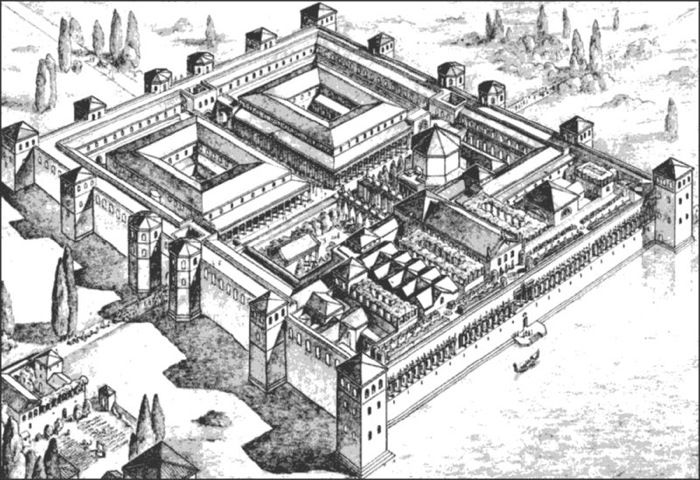
Drawing of the palace in its original plan
ST. DUJE (DOMNIUS) CATHEDRAL
The St. Duje Cathedral and bell tower is known as one of the oldest Catholic Cathedrals in the world and is located within the palace walls in the central square of Peristyle. The construction of this cathedral only began in the 13th century, long after the death of Emperor Diocletian as he was a persecutor of Christians. Ironically, this Cathedral was once the emperor’s mausoleum. The bell tower however, took about 300 years to construct. The cathedral has an octagon shape which is surrounded by a colonnade. Next to the entrance to the cathedral are is a black sphinx from 15 BC which was brought from Luxor in Egypt. In the cellar of the cathedral, tourists who enjoy historical religious artifacts can visit the treasury. Visitors can also climb to the top of the bell tower to enjoy 360 degree views of Split.
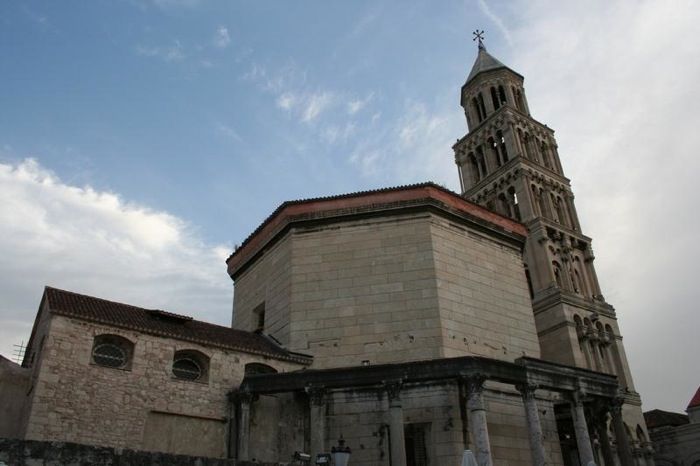
St. Duje's Cathedral and Bell Tower
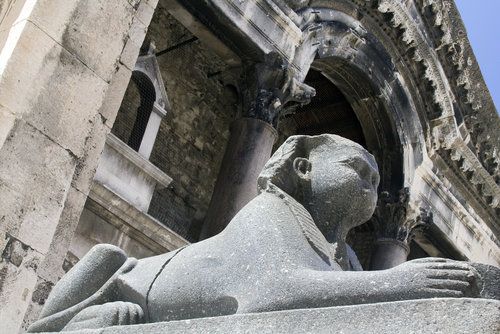
Egyptian Sphinx
THE BASEMENT HALLS
The substructure of Diocletian’s Palace consists of many rooms and the wallwork as supporting walls for the emperor’s residents above. In the past, these rooms were of no use as they were under water. The seaside entrance to the palace allowed ships and boats to enter the through this gate, and anchor below the place and enter straight onto the Peristyle central square. Myths say that the persecuted Christians were left in this substructure in the small rooms, preventing the bodies from flowing out. In the 1850’s, architect Vicko Andric started a project which drained and cleaned the cellars of Diocletian’s Palace, and created a Riviera on the seaside front of the palace which is known as Riva today. Today the cellar is the main area for souvenir shops that lead to the stairs that go the Peristyle square and St. Duje’s cathedral. Other parts of the substructure are used as temporary art exhibitions or function spaces.
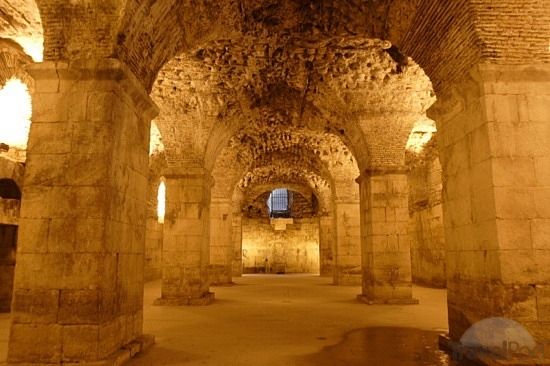
JUPITER'S TEMPLE
Jupiter was the name of Diocletian’s father and was also the highest Roman god. After the fall of the Roman Empire, the temple was converted into a Cathedral baptistery. Inside the small temple, there are two medieval stone coffins where the archbishops of Split, John and Luka are buried. Inside the temple there is a statue of Saint John made by the famous sculpture, Ivan Mestrovic. In the center of the temple there is a font basin which today is used as a wishing well as visitors throw coins in it. Originally, the temple never had a roof and this caused the rapid deterioration of the site due to environmental factors. The imposing arched ceiling has a series of face sculpured looking down on you. At the entrance of the temple, another Eqyptian sphinx can be found however, it has been vandalized and no longer has a head.
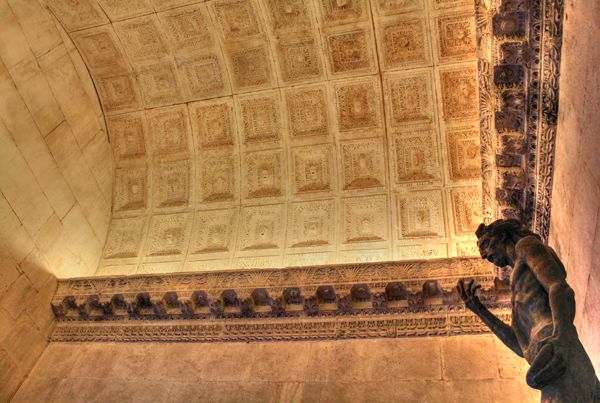
Interior pf Jupiter's Temple: Arched ceiling and statue of St. John
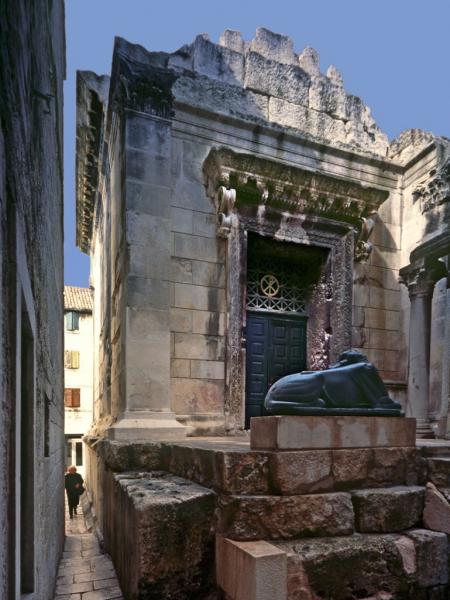
Jupiter's Temple with Headless Sphinx in Front
STATUE OF GRGUR NINSKI
The statue of Grgur Ninski, made my Ivan Mestrovic in 1929, is another well visited site for tourists. Previously, the statue was located in the central square of Peristyle but was moved in World War II, cut into three and dug underground to hide it from the occupying forces. It was re-erected outside the palace wall by the East, “Golden Gate” entrance. Grgur Ninski was the arch bishop of Split in the 10th century who also strongly opposed the Pope. Services were always held in Latin which was not understandable to the people of Croatia. Grgur Ninski then changed his services into the Croatian language which created more worship among the people as they understood their services and prayers. Some wearing has happened as it is believed that touching the toe of the statue brings luck. Over the years as more tourist visit the sight, it has been rubbed golden.
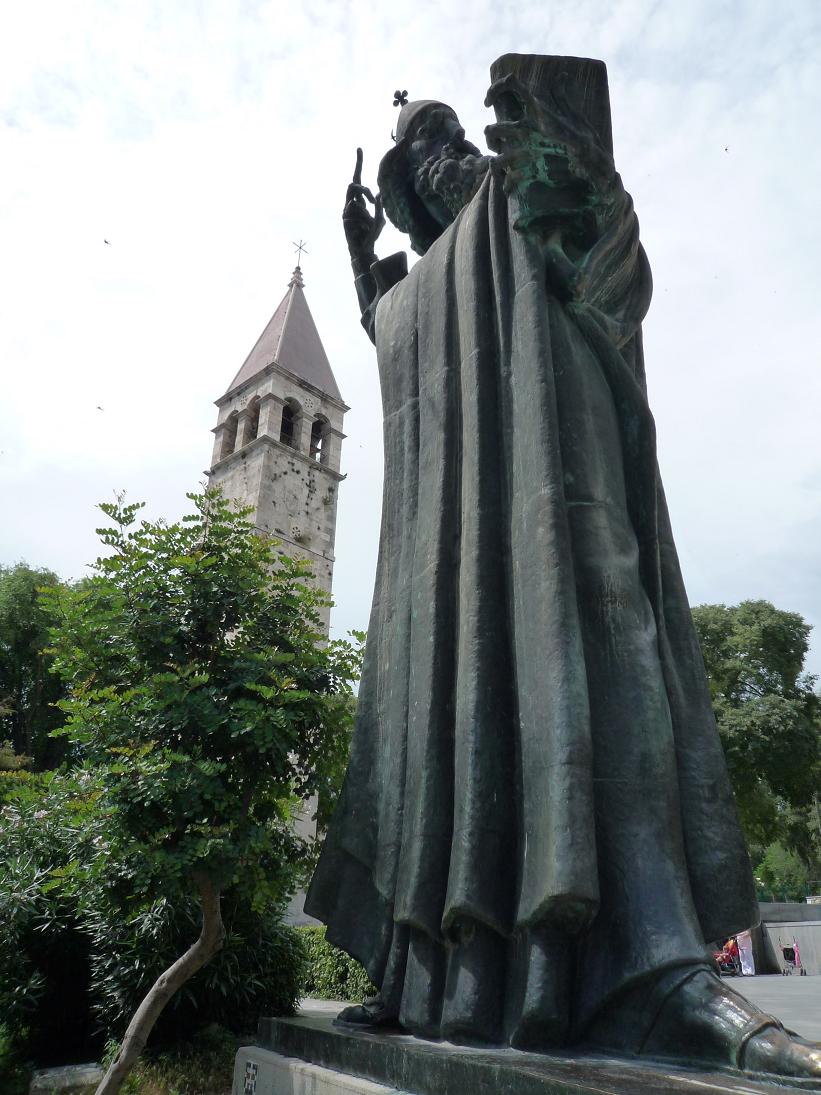
Statue of Grgur Ninski
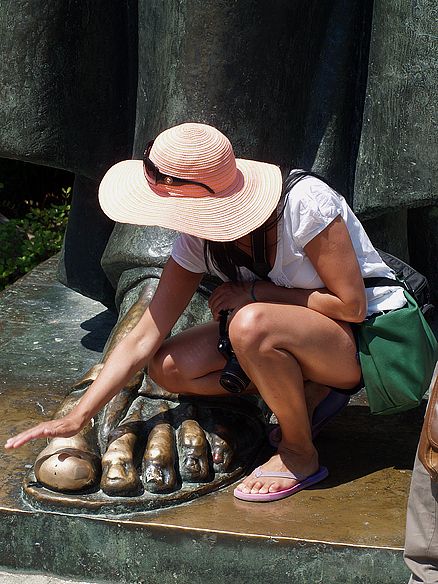
Make a wish!

